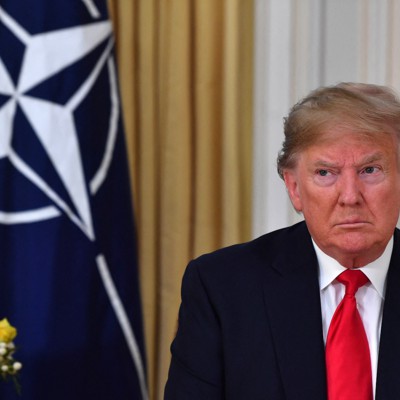The Trump administration wants NATO allies in Europe to “pay their fair share” for defense, while their governments want to build strategic autonomy, boost domestic defense industries, and fend off Russian aggression—now and in the future. Can Donald Trump’s tariffs—imposed and threatened—lead the sides to reconcile these worldviews?
European leaders, having prepared for months to respond to tariffs, have signaled they are ready to buy more American weapons and defense systems as part of a deal. The Trump administration should welcome this and indeed press European NATO allies to spend more on U.S. arms and technology—but also, crucially, to invest more in homegrown innovation and defense industrial capabilities.
Doing this would help rebalance transatlantic trade and continue to shift the burden of the bloc’s defense to European NATO countries, and it would also support longer-term European rearmament. This is a prerequisite for one of President Trump’s main policy goals: securing a ceasefire and lasting peace in Ukraine.
If rearming Europe and ending the war in Ukraine deters China, all the better.
A key question is how much new spending is realistically on the table. Last month at Davos, President Trump called on NATO members to increase their defense spending from 2 percent to 5 percent of GDP. This is beyond what any member state, including the U.S., currently spends on defense.
NATO has unofficially called on members to raise spending to between 3 percent and 3.5 percent of GDP, and European NATO members are probably ready to talk about the 3.5 percent figure, which matches current U.S. defense spending levels. Using 2025 GDP estimates, that translates to €630 billion per year, far more than the €350 billion or so they spent last year.
The Trump administration might be inclined to press for 5 percent and accept less from European capitals that agree to buy from American defense suppliers. But the U.S. would have more success by collectively holding European counterparts to the already ambitious 3.5 percent target.
Getting firm commitments will be a hard sell in either case. The continent’s sluggish growth and debt rules make new spending a challenge and European defense budgets have soared since Russia’s 2022 full-scale invasion. While Italy and Spain spend less than 2 percent, most European NATO members meet the bloc’s 2-percent guideline, and frontline countries like Poland manage to spend more than 4 percent on defense.
Poland’s approach shows higher spending is feasible—and the Italian and Spanish economies are some of the best-performing in the EU. But in all cases, finding extra funds will mean trading off other domestic priorities. The guns-versus-butter argument is not purely rhetorical in a time of budget cuts, political turbulence, and low growth.
This is why investment is key. European arms suppliers are fragmented and cannot meet rising demand. American arms contracts in 2025 and 2026 could help fill the gap, but leaning on allies to meet the 3.5-percent target would enable new investment in Europe’s domestic defense industries. With proper investment, European national and joint capacities could be significantly built out by 2026 and U.S. supply could then be redirected to other priorities.
Sending this kind of powerful signal soon would strengthen the allied position in negotiating and maintaining a ceasefire in Ukraine. It is obvious to Putin and others that a Europe that is materially more committed to its own defense and rearmed would be more reliably able to counter and deter future Russian aggression.
Tensions are sure to rise, but an all-out trade war between the U.S. and Europe would be the worst possible outcome of tariff negotiations and a major strategic loss for the United States. Damaging European economies would weaken their ability to sustain the spending required to meet strategic goals on Ukraine and Russia.
European allies are known to make tough decisions when faced with perceived major threats. U.S. tariffs are sure to have this clarifying effect, and the Feb. 14-16 Munich Security Conference could be where leaders come to alignment.
With Germany holding elections in February, Poland doing so in May, and continued uncertainty in French parliament, European leaders will soon be tempted to turn away from the hard questions of finding funds for more defense spending. NATO allies led by the U.S. have a small window in which to bolster their negotiating position with Russia and signal long-term shift towards European NATO responsibility.
The U.S. should seize this opportunity to rebalance trade and responsibility for transatlantic defense for years to come—and deter Russia and China in the process.
Dr. Alexandra de Hoop Scheffer is acting president of the German Marshall Fund of the United States.
Read the full article here








Leave a Reply